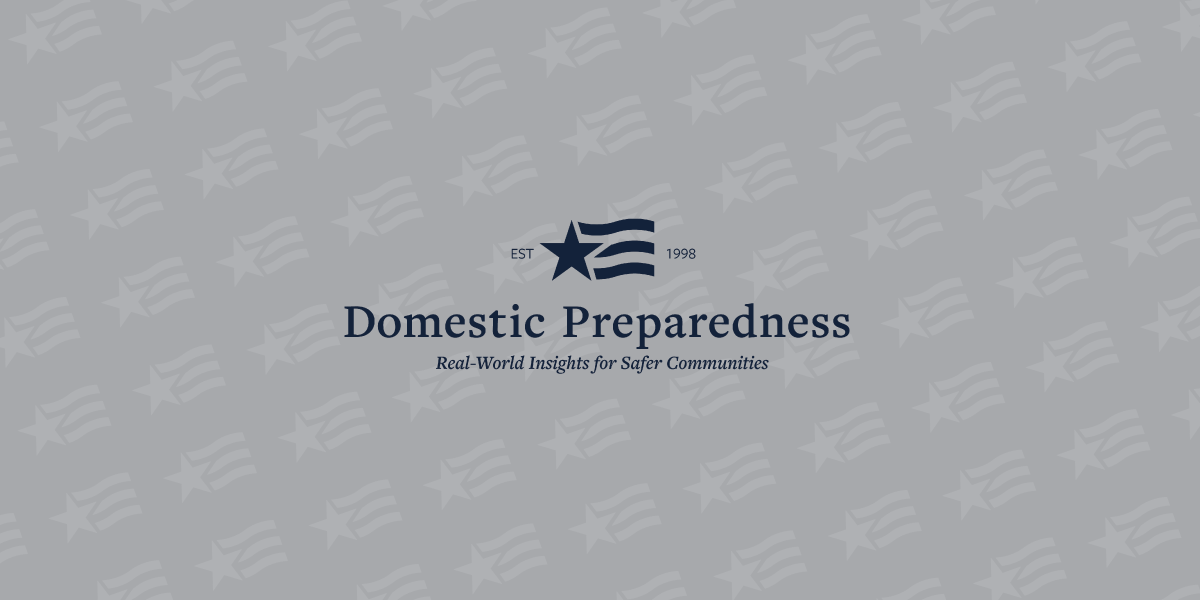- Agriculture & Food Defense, Articles, CBRNE, Communication & Interoperability, Critical Infrastructure, Emergency Management, Emergency Medical Services, Hospitals, Law Enforcement, Military, Public Health, Science & Technology, Terrorism, Transportation
- Greg Burel
In a world of increasingly complex and dangerous threats facing the United States – threats such as emerging infectious diseases, terrorist organizations, state actors, and extreme weather events – the Strategic National Stockpile (SNS) stands tall as a robust and reliable federal resource ready to respond. On 1 October 2018, in an effort to better align the stockpile with other federal medical countermeasure response efforts, the U.S. Department of Health and Human Services (HHS) shifted oversight and operational control of the SNS from the Centers for Disease Control and Prevention (CDC) to the HHS Assistant Secretary for Preparedness and Response (ASPR).
This shift has positive implications for stockpile operations. Shifting control to ASPR better positions the nation for the future by improving the efficiency of emergency responses, strengthening the government’s medical countermeasure procurement processes, and leveraging efficiencies in supply chain logistics.
The Evolution of the Strategic National Stockpile
To truly understand the importance of this organizational shift, it is critical to know first how the SNS got to where it is. The SNS was established 20 years ago with just a small staff and a stockpiling operation configured to respond within 12 hours to an unknown threat, such as how an anthrax event would have presented at the time. The idea was that this unknown threat would most likely be the result of a bioterrorist event. The 11 September 2001 terrorist attacks prompted federal legislation and directives as well as expanded funding for stockpiling capabilities to strengthen public health emergency readiness.
Since its founding in 1999, the organization has evolved to serve as the nation’s $7 billion federal repository of lifesaving vaccines, antibiotics and other medications, chemical nerve agent antidotes, modular Federal Medical Stations, and medical supplies for a public health emergency severe enough to cause local supplies to run out. Organized for rapid, scalable response to a variety of public health threats, the SNS today contains enough supplies to respond to multiple large-scale emergencies, simultaneously. Its warehouses and transportation partners across the country also can distribute anywhere in the United States with unmatched speed and efficiency.
SNS medical logistics operations consist of three main components: procuring medicines and supplies; managing and maintaining the SNS inventory; and deploying products to any public health emergency. The SNS holds medical material in strict compliance with 21 CFR ensuring safety and efficacy when called upon to respond. The stockpile has responded to more than 60 emergencies, including incidents as large as the 2009 H1N1 pandemic influenza response to an individual life-saving mission to treat someone who contracted anthrax naturally while visiting a national park in Montana.
The SNS has grown from just a few employees 20 years ago to a highly accomplished and dedicated staff of approximately 200 federal employees and contractors who serve as the federal government’s medical supply chain experts. To execute this awesome responsibility, SNS staff engage with state, local, tribal, territorial, and private sector partners every day. All these professionals coordinate across sectors to ensure that communities are prepared to use the supplies during public health emergencies. The material held is important but without the dedicated professionals who commit to the mission, that material would just be a useless collection of “stuff.”

SNS4: In an emergency, the Strategic National Stockpile can rapidly deliver medicines and supplies anywhere in the United States in less than 12 hours (Source: Strategic National Stockpile, date unknown).
Improving the Efficiencies of Emergency Responses
One of the primary responsibilities of ASPR is to lead and coordinate the public health and medical response for the federal government under the National Response Framework, Emergency Support Function #8. In this capacity, ASPR is on the frontline of helping communities prepare for, respond to, and recover from some of the most devastating threats to the public health and medical infrastructure of the United States. Partners from across the healthcare and medical supply chain sectors as well as state, local, tribal, and territorial governments collaborate with ASPR to improve readiness and response capabilities for the country.
Aligning the SNS with ASPR to improve emergency medical responses makes sense because much of what the stockpile does falls in line with ASPR’s role of preparing for and responding to infectious diseases, natural disasters, pandemics, and bioterrorism incidents. The work of the SNS intersects with a number of different federal agencies outside of ASPR and CDC, including the Department of Homeland Security, the Food and Drug Administration, the Department of Defense, the Department of Veterans Administration, and others. These agencies offer input to what is held in the stockpile, but having the SNS organizationally reside with ASPR – the coordinating entity for federal medical responses – promotes greater efficiency in making decisions on what to hold, how to prepare, and when to deploy.
Strategic procurement and stockpiling of medical countermeasures are necessary to protect Americans’ health and save lives. These FDA-regulated products (biologics, drugs, and devices) can be used to diagnose, prevent, protect from, or treat conditions associated with chemical, biological, radiological, or nuclear threats or emerging infectious diseases.
For many years, the stockpile has leveraged relationships with other federal entities to achieve better pricing and access to a variety of products. By working together with other parts of the government that need and procure the same material, significant savings are realized by increasing federal negotiating power. Combining collective needs can help the SNS enter into longer-term contracts and use more creative contracting mechanisms. For instance, this organizational shift will strengthen and streamline HHS’s national security vaccine and drug development and procurement enterprise, leading to better integration with other product development and procurement activities under ASPR.
Leveraging Efficiencies in Supply Chain Logistics
The stockpile represents a robust operation with billions of federal dollars invested in medicines and medical supplies and approximately 900 separate line items composing the SNS formulary. The total volume of stockpile products equates to more than 1.6 million square feet – racked six levels high. Many inventory items are kitted in unique configurations designed by the stockpile with other subject matter expert input. These products are stored in strategic locations to ensure their security and the SNS’s ability with its partners to deliver the right material at the right time to secure the nation’s health.

SNS3: The Strategic National Stockpile contains >$7 billion of medical countermeasures strategically located in warehouses across the United States (Source: Strategic National Stockpile, 2010).
Likewise, ASPR has a strong medical logistics capability that supports the National Disaster Medical System (NDMS) and moves medical personnel, equipment, and supplies across the nation within hours. The NDMS supplements health and medical systems during an emergency, and its medical professionals provide patient care, patient movement, and definitive care; contribute veterinary services; furnish fatality management support; and more.
Moving the SNS under ASPR’s management enables HHS to take advantage of synergies in supply chain logistics. ASPR can create contracting, logistics, and cost efficiencies and eliminate duplication. Just one example of an opportunity to leverage efficiencies is underway to decrease the warehouse footprint by combining NDMS medical supplies and equipment with SNS holdings.
Looking Ahead to the Next 20 Years
Since its inception, the stockpile has expanded and evolved to include an increasing number of products to protect more Americans from priority threats. The formulary also has expanded to cover emerging threats and include medical countermeasures to address those threats. An example of this expansion is the addition of pandemic influenza countermeasures acquired through supplemental appropriated funds. There also are forward-placed medical countermeasures through the development of the CHEMPACK program. Federal Medical Stations are part of the stockpile, as well, and include equipment and supplies for rapid deployment and set up to care for non-acute patients in areas of need, such as those affected by natural disasters.

FMS Setup GRB Convention Center: During a natural disaster, such as Hurricane Harvey in 2017, the Strategic National Stockpile can deliver Federal Medical Station to help areas in need. These caches of beds and supplies can serve up to 250 non-acute patients for 3 days before resupply is needed (Source: Strategic National Stockpile, Houston, TX, 2017).
A large part of the work SNS does is to remain flexible and scalable in order to respond to any need that arises. The alignment with ASPR only strengthens this resolve by positioning the stockpile with those federal responders at the forefront of health emergencies. The SNS will continue to work closely with governmental and nongovernmental partners to upgrade the ability to respond to a national public health emergency, ensuring that federal, state, and local agencies are ready to receive, distribute, and dispense products to those in need. With the support of ASPR and the improved access SNS has to medical response personnel in the field, the nation is more ready than ever to ensure the right material gets to the right place at the right time to protect people and save lives in an emergency.
Significant contributions to this article were made by Stephanie M. Bialek, Communications Section Chief, Division of Strategic National Stockpile, Office of the Assistant Secretary for Preparedness and Response, U.S. Department of Health and Human Services. She has 20 years of public relations and communications experience in government, academia, and health care and joined the federal government in 2010 to provide communications expertise and strategy for the Strategic National Stockpile. She holds both a bachelor’s and master’s degree in journalism and mass communications from the University of Georgia.

Greg Burel
Greg Burel is director of the Strategic National Stockpile, managed by the Department of Health and Human Services’ Assistant Secretary for Preparedness and Response. As head of the nation’s largest stockpile of medicines and supplies available for emergency use, he is a leading expert on medical supply chain management in the United States. With more than 35 years of civil service, he has risen through the ranks of the federal government, beginning his career at the Internal Revenue Service and serving in leadership roles in both the General Services Administration and the Federal Emergency Management Agency. In 2006, he assumed the helm of Strategic National Stockpile operations. He was awarded the Samuel J. Heyman Service to America Medal for Management Excellence and selected as a National Academy of Public Administration fellow in 2016.
- Greg Burelhttps://domprep.com/author/greg-burel
- Greg Burelhttps://domprep.com/author/greg-burel
- Greg Burelhttps://domprep.com/author/greg-burel
- Greg Burelhttps://domprep.com/author/greg-burel






